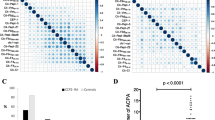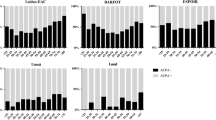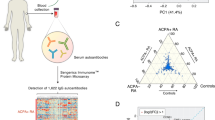Abstract
Transition from genetic risk to the development of systemic autoimmunity associated with rheumatoid arthritis (RA) is considered a key step for the development of RA and often referred to as the immune onset of the disease. The aim of this study is to identify predictors for the presence of anticitrullinated protein antibodies (ACPA) as a marker of systemic autoimmunity associated with RA in a high-risk population, an ongoing cohort of first-degree relatives of patients with RA. We assessed the presence of ACPA in individuals without clinical evidence of RA. We examined characteristics associated with ACPA positivity using general estimation equations to account for multiple observations per individual. A total of 1159 serum samples from 1025 subjects were analyzed, 69 samples (6%) were ACPA-positive, and 227 (20%) positive for rheumatoid factor. Participants had a median age of 45 years (interquartile range (IQR): 33–55) at baseline and 76% were women. Overall, ACPA positivity increased with age (p < 0.001). Among women, ACPA positivity was particularly associated with the age group 45 to 55 years (p = 0.003), but not among men (p = 0.7). In multivariable adjusted analyses, age older than 45, female sex and tobacco smoking were independently associated with ACPA positivity. In our cohort, the presence of ACPA was associated with older age and peaked in women around age 45 to 55 years, the perimenopausal period, suggesting that the development of ACPA may be favored by the decline in ovarian function.

Similar content being viewed by others
References
Klareskog L, Gregersen PK, Huizinga TW (2010) Prevention of autoimmune rheumatic disease: state of the art and future perspectives. Ann Rheum Dis 69(12):2062–2066
Gerlag DM, Raza K, van Baarsen LG et al (2012) EULAR recommendations for terminology and research in individuals at risk of rheumatoid arthritis: report from the Study Group for Risk Factors for Rheumatoid Arthritis. Ann Rheum Dis 71(5):638–641
Kokkonen H, Mullazehi M, Berglin E et al (2011) Antibodies of IgG, IgA and IgM isotypes against cyclic citrullinated peptide precede the development of rheumatoid arthritis. Arthritis Res Ther. 13(1):R13
Arkema EV, Goldstein BL, Robinson W et al (2013) Anti-citrullinated peptide autoantibodies, human leukocyte antigen shared epitope and risk of future rheumatoid arthritis: a nested case-control study. Arthritis Res Ther. 15(5):R159
Aletaha D, Neogi T, Silman AJ et al (2010) 2010 rheumatoid arthritis classification criteria: an American College of Rheumatology/European League Against Rheumatism collaborative initiative. Arthritis Rheum 62(9):2569–2581
Arlestig L, Mullazehi M, Kokkonen H et al (2012) Antibodies against cyclic citrullinated peptides of IgG, IgA and IgM isotype and rheumatoid factor of IgM and IgA isotype are increased in unaffected members of multicase rheumatoid arthritis families from northern Sweden. Ann Rheum Dis 71(6):825–829
Nielen MM, van Schaardenburg D, Reesink HW et al (2004) Specific autoantibodies precede the symptoms of rheumatoid arthritis: a study of serial measurements in blood donors. Arthritis Rheum 50(2):380–386
Finckh A, Müller RB, Möller B et al (2011) A novel screening strategy for preclinical rheumatoid arthritis (RA) in first degree relatives of patient with RA. Ann Rheum Dis 70:S3–282
Karlson EW, Sanchez-Guerrero J, Wright EA et al (1995) A connective tissue disease screening questionnaire for population studies. Ann Epidemiol 5(4):297–302
Infantino M, Manfredi M, Meacci F et al (2014) Anti-citrullinated peptide antibodies and rheumatoid factor isotypes in the diagnosis of rheumatoid arthritis: an assessment of combined tests. Clin Chim Acta 436:237–242
Sparks JA, Chang SC, Deane KD et al (2016) Associations of smoking and age with inflammatory joint signs among unaffected first-degree relatives of rheumatoid arthritis patients: results from the studies of the etiology of rheumatoid arthritis. Arthritis Rheumatol 68(8):1828–1838
El-Gabalawy HS, Robinson DB, Smolik I et al (2012) Familial clustering of the serum cytokine profile in the relatives of rheumatoid arthritis patients. Arthritis Rheum 64(6):1720–1729
van Schaardenburg D, Lagaay AM, Otten HG, Breedveld FC (1993) The relation between class-specific serum rheumatoid factors and age in the general population. Br J Rheumatol 32(7):546–549
Hensvold AH, Frisell T, Magnusson PK et al (2016) How well do ACPA discriminate and predict RA in the general population: a study based on 12 590 population-representative Swedish twins. Ann Rheum Dis. doi:10.1136/annrheumdis-2015-208980
Ursum J, Bos WH, van de Stadt RJ, Dijkmans BA, van Schaardenburg D (2009) Different properties of ACPA and IgM-RF derived from a large dataset: further evidence of two distinct autoantibody systems. Arthritis Res Ther 11(3):R75
Terao C, Ohmura K, Ikari K et al (2014) Effects of smoking and shared epitope on the production of anti-citrullinated peptide antibody in a Japanese adult population. Arthritis Care Res (Hoboken) 66(12):1818–1827
Kvien TK, Uhlig T, Odegard S, Heiberg MS (2006) Epidemiological aspects of rheumatoid arthritis: the sex ratio. Ann N Y Acad Sci 1069:212–222
Xavier RM, Yamauchi Y, Nakamura M et al (1995) Antinuclear antibodies in healthy aging people: a prospective study. Mech Ageing Dev 78(2):145–154
Hurme M, Korkki S, Lehtimaki T et al (2007) Autoimmunity and longevity: presence of antinuclear antibodies is not associated with the rate of inflammation or mortality in nonagenarians. Mech Ageing Dev 128(5–6):407–408
Ramos-Casals M, Garcia-Carrasco M, Brito MP, Lopez-Soto A, Font J (2003) Autoimmunity and geriatrics: clinical significance of autoimmune manifestations in the elderly. Lupus 12(5):341–355
Straub RH (2007) The complex role of estrogens in inflammation. Endocr Rev 28(5):521–574
Beydoun HA, El-Amin R, McNeal M, Perry C, archer DF. Reproductive history and postmenopausal rheumatoid arthritis among women 60 years or older: Third National Health and Nutrition Examination Survey. Menopause 2013;20(9):930–935.
Acknowledgements
This project received financial support from the Fonds National Suisse de la Recherche Scientifique (3200B0_120639/1–AF). Dr. Deshire Alpizar-Rodriguez granted the Swiss Government Excellence Scholarship for PhD studies of The Federal Commission for Scholarships for Foreign Students. Inova Diagnostics, San Diego, CA, United States, performed some of the laboratory tests including anti-CCP 3 (QUANTA Lite® CCP3 IgG) and RF QUANTA Flash® IgM and IgA.
Author information
Authors and Affiliations
Corresponding author
Ethics declarations
Disclosures
None.
Rights and permissions
About this article
Cite this article
Alpizar-Rodriguez, D., Brulhart, L., Mueller, R.B. et al. The prevalence of anticitrullinated protein antibodies increases with age in healthy individuals at risk for rheumatoid arthritis. Clin Rheumatol 36, 677–682 (2017). https://doi.org/10.1007/s10067-017-3547-3
Received:
Revised:
Accepted:
Published:
Issue Date:
DOI: https://doi.org/10.1007/s10067-017-3547-3




